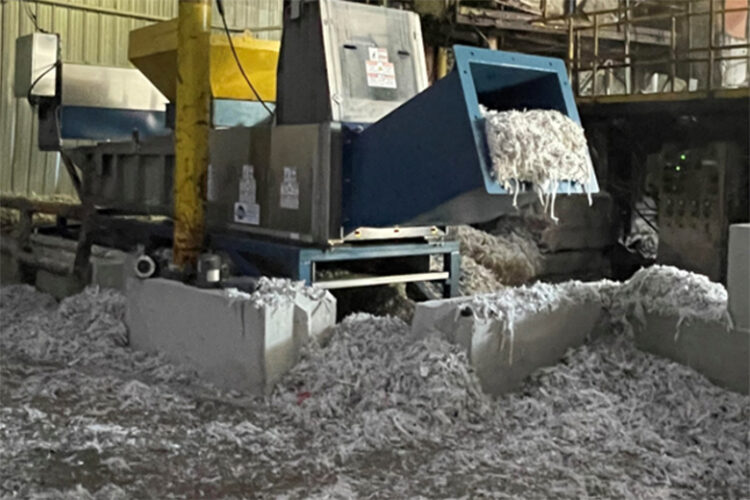Collaboration between an industry group and several Michigan organizations helped Great Lakes Tissue think outside the carton when it comes to its use of recycled material.
Michigan-based Great Lakes Tissue teamed up with the Carton Council of North America, the Michigan Department of Agriculture and Rural Development (MDARD) and the Michigan Department of Environment, Great Lakes and Energy (EGLE) to purchase new equipment that cuts down the amount of residuals generated by the toilet paper and tissue manufacturer.
The work also helps boost recycling of all components of recovered food and beverage cartons, which can contain plastic and aluminum along with the fiber that is used to make most of the packaging.
“We don’t want to just say cartons are recyclable, but it’s just the fiber,” said Jason Pelz, vice president of recycling projects for Carton Council of North America. “We want to say the whole thing is.”
Reality of 30% residuals
Pelz said the Carton Council was initially approached by EGLE with the opportunity to team up with Great Lakes Tissue.
Julie LaFond, plant engineer and general project manager at Great Lakes Tissue, said Great Lakes Tissue was looking to improve its internal recycling rate. The company brings in “100% recycled material, things that could potentially end up in landfill,” LaFond said, and turns it into toilet paper or other tissue products.
The process results in about 30% residuals, mostly polyethylene and poly/aluminum, so “our goal was to try to make that end material that’s left over more desirable.”
On the Carton Council’s end, Pelz said the goal is to be able to say cartons have a 100% yield, “so this is a very important part for us to help with.”
The Carton Council and EGLE each contributed $250,000 to the project, along with funding from MDARD. With that financial support, Great Lakes Tissue installed a high-density extruder to remove water from residual material, a compactor and a walking floor trailer to haul the material.LaFond said before adding the extruder, the residual material was about 60% or 65% water, which is “a lot of water we were shipping to landfill.”
Now, the residual material is at about 17% moisture, and more water is conserved. The company can compact the material more easily and fit more in each trailer load, further reducing costs.
Right now, the material goes down the road for a waste-to-energy operation, but Great Lakes Tissue and the Carton Council are working to find other options.
Pelz said “the ability to help as an offset to coal for waste-to-energy is good, but we know that’s not the final destination [we want].”
“We have some experiences around the world where this material has been turned into all kinds of things,” he said. “It’s been extruded into pellets and then turned into pallets or durable goods, roofing tiles, things like that.”
Learn more in person
Key fiber recycling trends will be fully explored in the What to Expect in Paper Markets session on Aug. 16 at the 2022 Resource Recycling Conference in Austin, Texas. The discussion will feature Bill Moore (president of Moore & Associates) and Martino Tavolato (U.S. director at Vipa Group). See full details on the session lineup and get registered today.LaFond said she’s confident they’ll find an end user, but when that happens it might take more support from their partners to seal the deal.
“They want to use the material but we need to have it baled, or they want to use the material but we need to shred it to make it a smaller size,” LaFond said. “Then again we’ll have another opportunity to look for more grant money and just further that partnership.”
Good results from ‘guinea pig’
Pelz said he and the Carton Council are very open to working with other mills on similar projects.
“Great Lakes Tissue is the guinea pig, but they’re being very successful with it,” he noted.
“Great Lakes Tissue is the first one who’s done it, but it could be replicated,” he said. “Whether it would be a copy-paste or whether it might need to be a little different, I don’t know, but I would say it shows that there’s a pathway.”
However, this model is not the only possibility, Pelz stressed.
Partnerships are critical, Pelz added, because “I don’t think any one trade organization, any one paper mill, any one whatever is going to make this work when we look at trying to recycle things and get the most value.”
“Nobody should look at this and think they have to solve all these things on their own,” he said. “There’s a match out there for you or your problem, it’s just having the foresight to find those folks. We were lucky because we picked a great partner with Great Lakes Tissue and we’re really excited about it. It’s something to build on.”
LaFond said she’s now evaluating all of what Great Lakes Tissue sends to landfill and trying to see if there’s another solution.
“All I would say is don’t be afraid to look at what you’re putting in the landfill and try to think about someone who might be able to use it for something,” she advised.


























